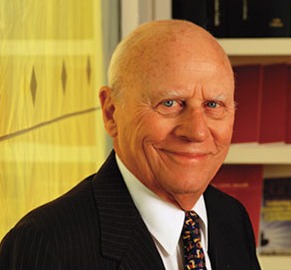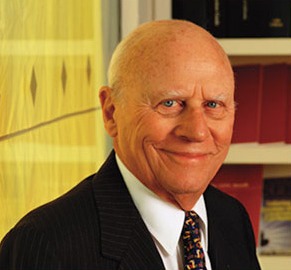 Richard Goldman.Photo: The Goldman Environmental PrizeThe planet lost a great and generous hero on Monday when philanthropist Richard N. Goldman died at the age of 90. Goldman is most famous for cofounding the Goldman Prize, $150,000 awarded annually to a grassroots environmental activist on each of six inhabited continents.
Richard Goldman.Photo: The Goldman Environmental PrizeThe planet lost a great and generous hero on Monday when philanthropist Richard N. Goldman died at the age of 90. Goldman is most famous for cofounding the Goldman Prize, $150,000 awarded annually to a grassroots environmental activist on each of six inhabited continents.
It seems as if Goldman died happy. “I see this as the most meaningful philanthropy I’ve been involved in,” he said at the 1994 Goldman Prize Reunion. “It has a future value, and really, if I died now, I’d die with a smile.”
The Goldman Prize quickly grew in stature to such a degree — with an annual celebration at the Capitol hosted by House Speaker Nancy Pelosi, for instance — that it became known as the “green Nobel.” Indeed, one of its early winners, Green Belt Movement founder Wangari Maathai, went on to win the actual Nobel Peace Prize, buoyed in part by the attention and funds she received from Goldman. “He was an extremely generous man who reached out to the whole world to encourage grassroots work, and he discovered me and a fellow Kenyan, Michael Werikhe,” Maathai said. “This was extremely visionary because so much is done at the grassroots level, and quite often it’s just not recognized.” The prize also helped inspire environmental campaigns and movements in developing world countries that previously had only very limited involvement.
This year’s winners embody the kind of courage that Goldman sought to cultivate: Randall Arauz fought shark-finning in Costa Rica after secretly videotaping Taiwanese fishermen illegally unloading 30,000 shark fins at a private dock in Costa Rica — ultimately leading to a nationwide ban on the practice, and making the small Central American nation a global leader in shark protection.
Closer to home, Michigan Sierra Club activist Lynn Henning won the prize for her work to expose illegal pollution from Concentrated Animal Feeding Operations (CAFO’s) after her in-laws, who live 1,000 feet from a CAFO, were diagnosed with hydrogen sulfide poisoning. When she began organizing to stop CAFO expansion, she became the target of intimidation and harassment: her mailbox was blown up, dead animals left on her porch, and she was run off the road while tracking pollution. Lynn’s story of facing down violent people dead-set on wreaking havoc on nature and people for short-term profit was a common one at Goldman Prize events, whether in Michigan or Mozambique. Most famously, Goldman Prize winner Ken Saro-Wiwa was hanged by Nigeria for organizing against Shell Oil’s pollution of his native Ogoniland.
The prize winners were themselves greatly inspired by Goldman. Nine months after winning the 2005 prize, Corneille Ewango of the Democratic Republic of Congo and his wife, Esialambele, named their new daughter Rhoda after Goldman’s wife.
Goldman’s support of grassroots activists came despite the fact that he himself came from a background usually very unlike those of the people he was supporting. He was a hybrid-driving Republican who had founded a successful brokerage — and married a grand-niece of Levi Strauss.
“I think the interesting contradiction was Richard Goldman was a creature of the American establishment,” Carl Pope, executive chairman of the Sierra Club, told The Los Angeles Times. “This was the ultimate insider consistently recognizing the ultimate outsiders.”
Goldman’s influence went far beyond the prize, however. The Richard and Rhoda Goldman Fund, which he and his wife founded in 1951, started making grants for conservation and environmental protection in the early 1960’s, one of the very first philanthropic organizations to do so. Although Goldman’s environmental giving touched every corner of the planet and almost every issue, he always has a special place in his heart for the survival of California’s ecosystems — and invested millions of dollars in protecting redwood forests, making California a leader in solar power, and saving California’s majestic high Sierras and stunning sealife.
I personally experienced Goldman’s generosity when my former employer (and current client) Avoided Deforestation Partners received a grant from the Goldman Fund last year, one of many they financed to protect forests around the world. Indeed, the Goldman Fund was one of the original supporters of efforts, largely run by the Rainforest Action Network, to reduce demand for products driving deforestation such as soybeans, beef, and palm oil, and to promote more sustainable agriculture and practices. Goldman also funded population efforts such as the Center for Reproductive Rights, Planned Parenthood, and the International Women’s Health Coalition — providing needed resources to a vital area of public policy that has been largely neglected by many other environmental funders.
“When Rhoda and I got married, it sounds corny, but we said we wanted to make the world a better place,” Goldman told the San Francisco Chronicle in 2009.
In addition to his environmental efforts, Goldman also generously funded education in the California Jewish community and several universities in Israel. But even in the Holy Land, he tied in his passion for protecting the planet by promoting solar power in Israel’s sun-soaked deserts and funds for the Society of the Protection of Nature in Israel. He also supported cultural, educational, and public interest projects in his beloved Bay Area.
Many of these buildings will be Richard Goldman’s bricks-and-mortar memorials. But, as with any great planet defender, Goldman’s true legacy will be those sacred places around the world that, thanks to him, lack any concrete at all.



